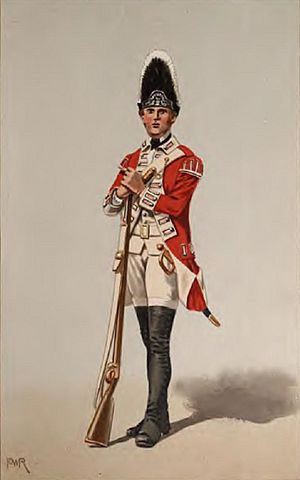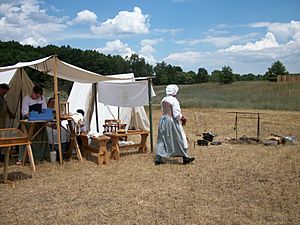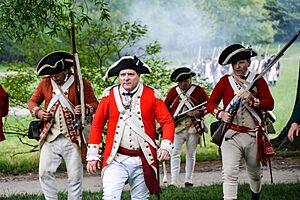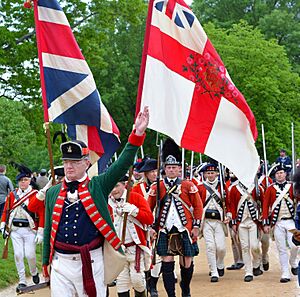British soldiers in the eighteenth century facts for kids
The experience of a British soldier in the 1700s changed a lot depending on where they were, what time it was, and who they were fighting. The British Army went through big changes during this century. These changes helped them fight well in many wars, like the War of the Spanish Succession, the Seven Years' War, and the American War of Independence.
Life for these soldiers was often very tough. Rules were strict, and even small mistakes could lead to harsh punishments. Soldiers needed a lot of training before they could go to battle. This strict training helped Britain become one of the strongest powers in Europe by the end of the 1700s.
Contents
Joining the Army

The British Army in the 1700s was known for being very disciplined and strict. Life in army camps was often dirty and crowded, which meant diseases could spread quickly. Punishments could be very severe, from a flogging (being whipped) to even a death sentence.
Even with these tough conditions, many men chose to join the army. Some wanted to escape hard lives in cities. Others hoped to travel the world or earn a steady wage.
How Soldiers Were Recruited
Men joined the army in different ways during the 1700s. The regular army used special groups to find new soldiers. Sometimes, they even used "press gangs" to force men to join.
Other groups, like the militia, chose men by a lottery system. This started with the Militia Act of 1757. There were also many part-time soldiers called "volunteers." Joining as a volunteer meant you didn't have to join the militia. Part-time service was much easier than the strict life of the regular army.
Men joined for many reasons, not just patriotism. Many who volunteered were unemployed city workers. The chance of a regular income was better than having no money at all. Some joined because they feared an invasion. They wanted to protect their own money and property.
Becoming an Officer
Many men who wanted to become officers had to buy their position. This was very expensive, costing about £450. Only wealthy families could usually afford this for their sons. Being an officer brought respect and a higher social status.
Later, the Duke of York changed the rules for buying officer positions. Officers had to serve for two years before they could be promoted to captain. They needed six years before becoming a major. This helped make officers more experienced and better at their jobs.
Weapons and Gear
The main weapon for British soldiers in the 1700s was the Brown Bess musket. This musket had been used since the 1730s. It used a flintlock mechanism, which was more reliable than older systems.
The long pike weapon was replaced by muskets with Bayonets. A bayonet was a knife attached to the end of the musket. This allowed soldiers to fight hand-to-hand while still being able to fire their musket. It turned the musket into a pike-like weapon.
A well-trained soldier could fire their musket up to three times a minute. If a soldier was too slow or missed too much, they might get a light punishment. The British army used a "platoon formation." This allowed them to fire a constant stream of shots.
Muskets could have problems. They might misfire in wet weather or fire by accident. Sometimes, a soldier might forget to remove the ramrod before firing. Even with these issues, the musket was effective for distances between 70 and 100 yards (64 to 91 meters).
Life in Camp
When soldiers were on a battlefield, their camps were very simple. They only carried the most basic things because everything had to be moved when the army traveled.
A typical group of soldiers (about 792 men) would carry 160 tents, cooking kettles, hatchets, water flasks, and knapsacks. The amount of gear changed based on the size and type of the group. For example, Dragoons (soldiers on horseback) needed extra equipment for their horses.
Camp conditions were often poor. Camps had to be set up wherever there was space. Basic things like fresh water had to be collected from nearby. Toilets often had to be dug after setting up camp. Personal space was limited. However, this often created a strong sense of friendship among the soldiers.
When not fighting, soldiers stayed in barracks or billets (private homes). Life there wasn't much more comfortable. A group of 5-6 men might share living quarters and supplies. Sometimes, men even shared a blanket for sleeping.
Rules and Punishments
Life in the army was very strict. Even small mistakes were punished. Courts made up of officers decided the punishments.
Common crimes included stealing and general bad behavior. A wrongdoer might be punished by "running the gauntlet." This meant being whipped by their own fellow soldiers as they walked between two lines of them.
One serious crime was desertion (running away from the army). If caught, a man could be branded with a "D." If he ran away again, he could be executed. Death sentences were not very common. Hanging was usually for murderers, and being shot was for repeat offenders.
Punishments happened in front of other soldiers and officers. The shame was meant to stop others from doing the same thing. Once a soldier was punished, they were usually accepted back into their group without further problems.
Camp Followers
When the army was on the move, a large group of people followed them. These included "sutlers" who sold goods to soldiers, and women who chose to follow their husbands or partners to war.
The number of women following the army varied. Sometimes, there were up to 17 women for every 100 men. These women were expected to work. They cooked, washed, and often acted as nurses. They could earn money from the army for their services. Sutlers also made money selling things like coffee, drinks, and beer to the soldiers.
Camp followers usually had to follow the same army rules as the men. A sutler could be whipped or even killed if caught selling things without permission. Stealing and not following orders were also common offenses.
Some people complained about women and children being in the camps. They felt they distracted the soldiers or caused trouble.
Daily Life of a Soldier
A soldier's career could be very tough. Their red uniforms were often uncomfortable and made it hard to move. However, soldiers often changed their uniforms to be more comfortable when fighting. Soldiers got a daily wage, but after buying food and equipment, they had little money left for luxuries.
What Soldiers Wore
When marching to war, soldiers wore a red uniform. This included a special regimental coat, a white shirt, grey trousers, shoes, and a cap. The cap might be a Tricorne hat or a Stovepipe Shako. Later, most regiments used the "Belgic shako." Soldiers also wore a grey wool greatcoat, usually tied to their knapsack.
Sometimes, the bright, fancy uniforms attracted men to the army. Wearing the distinctive red uniform was a big change from the dull clothes most men wore daily.
When in camp, soldiers wore a lighter white uniform made of linen. This was more comfortable for working.
Different regiments had different colored "facings" (parts of the uniform) to show who they were. For example, the 24th Regiment of Foot used "Willow Green" facings. Units were also identified by their flags, called "colours."
Soldiers had rules for their hair too. They had to wear it in a "queued" style, tied back and ten inches long. Officers' uniforms were usually brighter and had different styles. They also wore a decorative metal plate called a gorget around their neck.
Infantry soldiers often wore two white leather straps across their chests, forming an "X." One strap held a bayonet, and the other held a cartridge box. Officers wore one shoulder belt for their sword or pistol ammunition. These belts had a plate in the middle that showed the soldier's regiment. Soldiers used white clay to keep their belts clean and white.
What Soldiers Ate
When fighting, soldiers usually received bread, meat, oatmeal or rice, and beer or rum. A typical daily amount for a group of six men included bread, beef, rice or oatmeal, and rum. A soldier in camp might get a loaf of bread that lasted about four days.
A common meal was beef broth and potatoes. Stews and meat pies were also cooked often. "Small beer" (a weak beer) and rum were watered down to make them last longer. Small beer was also brewed to kill germs in the water, which helped stop diseases.
Food was often sent to the troops, but there were often shortages. So, it was easier for soldiers to find food from the land they were on or buy it from local people. Vegetables were grown, and animals were raised to feed the troops. However, many reports said soldiers got sick because they didn't have enough good food. How well troops were fed depended on the area they were in and how good their commanders were.
How Much Soldiers Were Paid
A British soldier's daily pay depended on their rank. A sergeant might earn between 1 shilling 6 pence and 2 shillings 6 pence. A trumpeter could earn up to 2 shillings 8 pence. A regular private soldier might get 8 pence if they were in a foot regiment, but almost 2 shillings 6 pence if they were in the cavalry. To compare, a laborer in the mid-1700s earned about 2 shillings a day.
Soldiers had to pay for extra food, animal feed, and other things like beer from their wages. A loaf of bread cost about 5 pence. From 1800 onwards, soldiers also received a daily "Beer money" allowance.
Many camp items cost a few shillings. A haversack might cost 3 shillings 6 pence. Larger items like tents were more expensive. Tents were usually provided by the government, but other items might be bought by the regiment's colonel, who would then be paid back.
| Rank | Horse | Dragoons | Foot |
|---|---|---|---|
| Colonel | £2 1s 0d | £1 15s 0d | £1 4s 0d |
| Lieutenant-colonel | £1 9s 6d | £1 4s 6d | 17s 0d |
| Major | £1 7s 0d | £1 0s 6d | 15s 0d |
| Captain | £1 1s 6d | 15s 6d | 10s 0d |
| Lieutenant | 15s 0d | 9 s 0d | 4s 8d |
| Cornet | 14s 0d | - | - |
| Ensign | - | 8s 0d | 3s 8d |
| Quartermaster | 8s 6d | 5s 6d | 4s 8d |
| Chaplain | 6s 8d | ||
| Surgeon | 6s 0d | 4s 0d | |
| Surgeon's Mate | - | - | 2s 6d |
| Adjutant | 5s 0d | 4s 0d | |
| Kettle Drummer | 3s 0d | - | - |
| Trumpeter | 2s 8d | - | - |
| Drummer | - | 2s 0d | 1s 0d |
| Serjeant | - | - | 1s 6d |
| Corporal | 3s 0d | 2s 0d | 1s 0d |
| Hautboys | - | 2s 0d | - |
| Private Man | 2s 6d | 1s 6d | 0s 8d |
| Source: | |||
| Rank | Staff | Gunners | Pioneers |
|---|---|---|---|
| Colonel | £1 5s 0d | - | - |
| Major | 15s 0d | - | - |
| Engineer | 10s 0d | - | - |
| Captain | - | 10s 0d | 4s 0d |
| Lieutenant | - | 6s 0d | - |
| Gentleman of the Ordnance | 4s 0d | - | - |
| Paymaster | 10s 0d | - | - |
| Chaplain | 8s 0d | - | - |
| Surgeon | 5s 0d | - | - |
| Assistant Surgeon | 3s 0d | - | - |
| Adjutant | 6s 0d | - | - |
| Kettle Drummer | 4s 0d | - | - |
| Serjeant | - | 2s 6d | 2s 0d |
| Corporal | - | 2s 0d | - |
| Gunner | - | 1s 6d | - |
| Matross | - | 1s 3d | - |
| Pioneer | - | - | 1s 0d |
| Source: | |||
| Rank | Horse | Dragoons | Foot | Royal Irish Artillery |
|---|---|---|---|---|
| Colonel | £1 18s 0d | £1 11s 4d | £1 4s 6d | - |
| Colonel Commandant | - | - | - | £2 0s 0d |
| Lieutenant Colonel | £1 5s 0d | 19s 4d | 16s 6d | £1 0s 0d |
| Major | £1 2s 6d | 17s 4d | 14s 6d | 15s 0d |
| Captain | 17s 0d | 12s 4d | 9s 6d | 10s 0d |
| Captain Lieutenant | - | - | 4s 6d | 6s 0d |
| First Lieutenant | - | - | - | 5s 0d |
| Lieutenant | 10s 6d | 7s 2d | 4s 6d | - |
| Second Lieutenant | - | - | - | 4s 0d |
| Cornet | 8s 6d | 6s 2d | - | - |
| Ensign | - | - | 3s 6d | - |
| Quartermaster | 5s 0d | 4s 0d | - | - |
| Serjeant Major | - | - | - | 2s 6d |
| Serjeant | - | 2s 6d | 1s 6d | 2s 0d |
| Corporal | 2s 6d | 1s 8d | 1s 0d | 1s 10d |
| Bombardier | - | - | - | 1s 8d |
| Private Man | 1s 6d | 1s 2d | 0s 6d | |
| Gunner | - | - | - | 1s 0d |
| Source: | ||||
How People Saw the Army
The term "redcoat" was sometimes used to make fun of soldiers. In the American colonies, they were even called "lobsters." People's opinions of soldiers changed over time. They could be seen as poor and helpless, but also celebrated during victories.
Parades and celebrations often included army units. These events were important for showing community pride. Even though some people questioned if a standing army was needed, the government could quickly use its forces when there was fear of invasion. This shows that many people supported the army. Public opinion of the British Army improved as the long wars with France continued. This led to important changes in how the army was structured and trained.
See also




